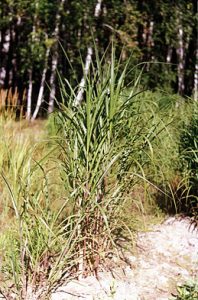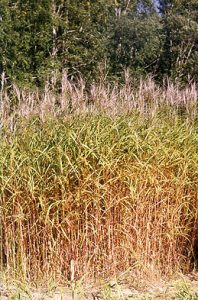Institute of Cytology and Genetics, SB RAS, Novosibirsk
Head of the Institute:
Vladimir K.Shumny, Academician of the RAS
10 Lavrentiev Ave., Novosibirsk, 630090, Russia
Tel.: +(383-2) 33-35-26
Fax: +(383-2) 33-12-78, 33-34-66
email: shumny@bionet.nsc.ru
Principal researchers:
V.A.Godovikova
email: god@cgi.nsk.su
Project objectives
There are some goals of Miscanthus investigation:
1. The main goal is the study of native biodiversity of Miscanthus.
2. Using a complex of modern biotechnologies, to develop in vitro methods for inducing species polymorphism for selecting new genotypes better adapted to local environmental conditions, as well as the elaboration of better methods for microclone propagation of some clones.
Background and significance of objectives
There is a large collection of biodiversity of three species of Miscanthus. It is initial germplasm material for plant breeding of Miscanthus in two directions. The first one – selection for adaptivity to unfavourable environmental factors such as dryness and salinity.
Preliminary data obtained after the 5 years of investigations run on a special testing ground, situated on the bottom of Chany, a salt lake in Western Siberia allowed us to find some salt tolerant genotypes.
The second direction of selection is breeding for high bioproductivity.
In 1992, within the framework of an international program of searching for a new resumed source of biomass and raw material alternative of wood, an all-round study of some perennial low-maintenance energy plants was started at the Institute of Cytology and Genetics.
Research plan: approaches and methods
There are three endemic species of the genus Miscanthus in Russia
in the Far East, where savannah-like compositions are formed by their grouping with species of Arundinella Raddi., Mulenbergia Schreb. and Querqus mongolica L. (Tsvelev, 1897).
These are – Miscanthus sacchariflorus Maxim.
Miscanthus purpurascens Anderss. and Miscanthus sinensis Anders., from the tribe Andropogoneae, the family Poaceae (Voroshilov, 1982).
Due to polymorphism, taxonomically, Miscanthus is a very complex genus, which causes dispute when another individual is to be classified.
During two expeditions, which covered the area between the northern part of Primorsky Kray, a unique original plant material was gathered in the vicinity of Khasan Lake and the Russia/Korea border.
There is a germplasm collection of seeds and initial plants of distinct varieties and ecotypes of Miscanthus species.
Material was described, systematised and transplanted into a field experimental station and hydroponic greenhouse.
In spite of good pollen fertility, we have not received any seeds 85-95%. This phenomenon can have been be caused by high self-incompatibility in Miscanthus, their hybrid origin or environmental conditions of Siberia. Gathered in native populations, wild seeds have too low viability and extremely poor seed-set, hence unreliable propagation through seeds.
For solving the seed problems, in vitro biotechnology methods were used.
Expected results
We plan receiving a row of new plant regenerants for all three species of Miscanthus.
Within the framework of an ecological program for rehabilitation and recultivation of pollutant- and industry-disordered soils by wastes of the poultry farm in the Novosibirsk region, we expect to obtain new results after planting 50 thousands Miscanthus plantlets.
List of publications of participants related to the project
-
Godovikova V.A., Shumny V.K. In vitro techniques of cell and tissue culture and plant regeneration of Miscanthus Anders // Plant Biotechnology and molecular Biology: Second Symposium “Trend in Plant Biotechnology”, Russia, May 18-20. ñ 1993. ñ P. 365.
-
Godovikova V.A., Shumny V.K., Moiseeva E.A. Cell and tissue culture of Miscanthus sacchariflorus // Proceeding of the 2nd Biomass Conference of Americas: Energy, Environment, Agriculture and Policy. USA, Portland, Or., 21-24 August 1995. ñ P. 350-356.
-
Shumny V.K., Godovikova V.A., Moiseeva E.A. Introduction of Miscanthus in Russia // Proceedings of Second Biomass Conference of Americas: Energy, Environment, Agriculture and Policy. USA, Portland, Or., 21-24 August 1995. ñ P. 343-349.
-
Gulevich R.G., Godovikova V. Siberian medical plants for fertility regulation // I International conference of medical plants for conception and contraception. 25-26 November 1995 Taipei Taiwan, Republic of China.
-
Godovikova V.A., Gonchar A.M., Shumny V.K. Some perspectives of industry introduction of new clones of Miscanthus for ecological reestablishment of saline lands and foundation of renewable resource base // Abstr. 9th European bioenergy conference, 24-27 June 1996 Copenhagen, Denmark. ñ P. 176.
-
Godovikova V.A., Shumny V.K. Introduction of Miscanthus in Siberia: Problems and Perspectives // Nachwachsende Rohstoffe: Repositions Pflanzen, red. Orth, Berlin, 1996. ñ P. 21-27.
-
Nechiporenco N.N., Godovikova V.A., Shumny V.K. Physiological and genetical basis for selection of Miscanthus // Aspects of Applied Biology. ñ 1997. ñ Vol. 49. ñ P. 245-249.
Fig.1. M.sinensis Anderss.
Fig. 2. M. purpurascens Anderss.
Fig. 3. Miscanthus sacchariflorus Maxim.
Fig. 4. Miscanthus collection





